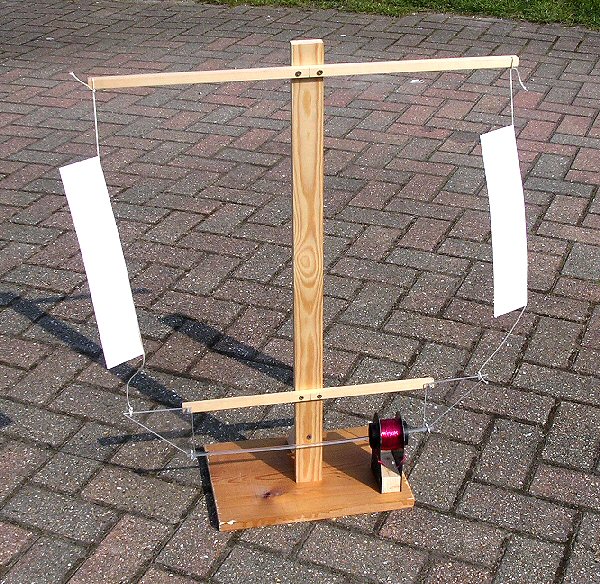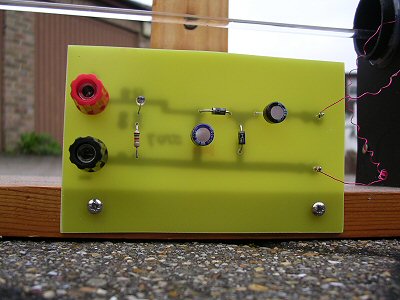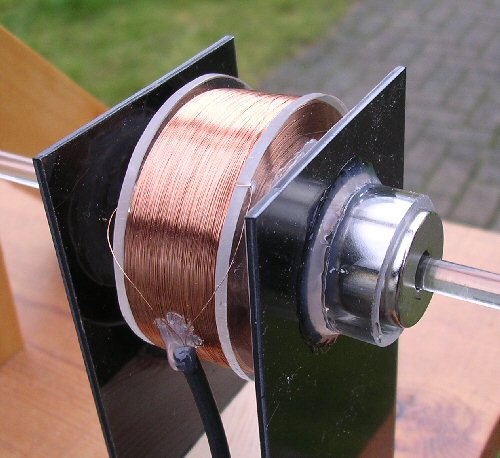
The Fluttermill with shake-a-gen attached

The basic idea is that there are two sails (in the simplest case these can be rectangular sheets of card or thick paper) attached to strings. These are hung vertically from a frame (see picture above). Each sail string goes via a right angle pulley arrangement to a horizontal bar (or string). When the wind blows and the sails flutter they pull the strings. Only one sail can pull at any one time because the one that is pulling causes the string on the other sail to tighten up (due to the mechanism movement). This ensures a nice see-saw action.
One very nice aspect of this idea is that the sails simply move around the string axis following the wind so you don't have to move the windmill to track the wind. It's probably the simplest / most basic vertical axis windmill there is.
At any one time, the sails and strings will probably be moving at slightly different times causing the horizontal bar to move back and forth (left to right, right to left etc.) - the sea-saw action. If a magnet is fixed on to the bar and a shake-a-gen coil placed around the magnet the wind will move the magnet and generate electricity in the coil - the wind shakes the shake-a-gen magnet.
We have a flutter windmill powering a shake-a-gen !
For the prototype I used a 1000 turn shake-a-gen coil made from a plastic pipe (ca. 4cm diameter x 5cm long). You will notice that the generator coils are offset from the center of the prototype. This was because I used a support near to this spot to strengthen the mast and the metal screw kept interacting with the strong shake-a-gen magnet!
I tried various magnets. The 6mm thick, 2.5 cm diameter magnet used in the original shake-a-gen only produced short bursts of light from the LED and only then when the wind was very strong and blustering. Using the storage device with this smaller magnet might still produce usable quantities of electricity though. I then tried a much longer magnet (ca. 3cm x 2.0 cm diameter) and of course it produces more reliable electricity - the LED lights with a good wind. Magnets are now available cheaply from various firms on e-bay for example.
The problem with LED lights is that they need a certain threshold voltage before they will start to light. In these low voltage circuits a x2 voltage doubler circuit really helps make the LED brighter and will also convert the AC signal to DC for other uses, see voltage multiplier page
I have a feeling that a shorter coil would work better (i.e the same diameter but not so long). The one shown in the photo is ca. 2-3 cm long and reducing it to ca. 1.5 cm might be better (it would of course be thicker but there is plenty of room). This is because the average magnet movements are generally quite small and a shorter coil would mean the magnet motion would cover a greater volume of the coil - hopefully generating more electricity per mm of movement (although it also depends on how fast, and not just how much the magnet moves). I tried putting 500-1000 turns over 1cm but it didnt seem to work better, however the last windings were much further away from the moving magnet .... I need to experiment some more.
I made the right angle pulleys from Plexiglas for strength but cheap plastic set squares might work as well. Ideally the pullies should be as lightwight as possible so you could drill out some of the trangle to save weight.

I used a spare piece of plastic tube that I had for the horizontal bar but a piece of dowel or bamboo might work better as it may well be stiffer and lighter.
Normal parcel type string will work fine on the sails. I used nylon string as I had some in the garage. The sails were made from ca. 20 cm x 4cm thin card and taped onto the string about midway. On a blowy day the strings have a tendency to un-tie themselves so once you feel that you have the design working it's probably worth taping the lose ends. A coat of varnish on the sails or covering the paper with parcel wrapping tape might also be worth trying to weather proof (or use plastic sheet for the sails).
The shake-a-gen storage device (full wave rectifier and capacitor smoothing) would really make this little windmill work very well for powering an LED, small radio or perhaps for a charging a low voltage rechargeable battery with a good breeze / wind.



THE CREATIVE SCIENCE CENTRE
home | diary | whats on | CSC summary | latest news